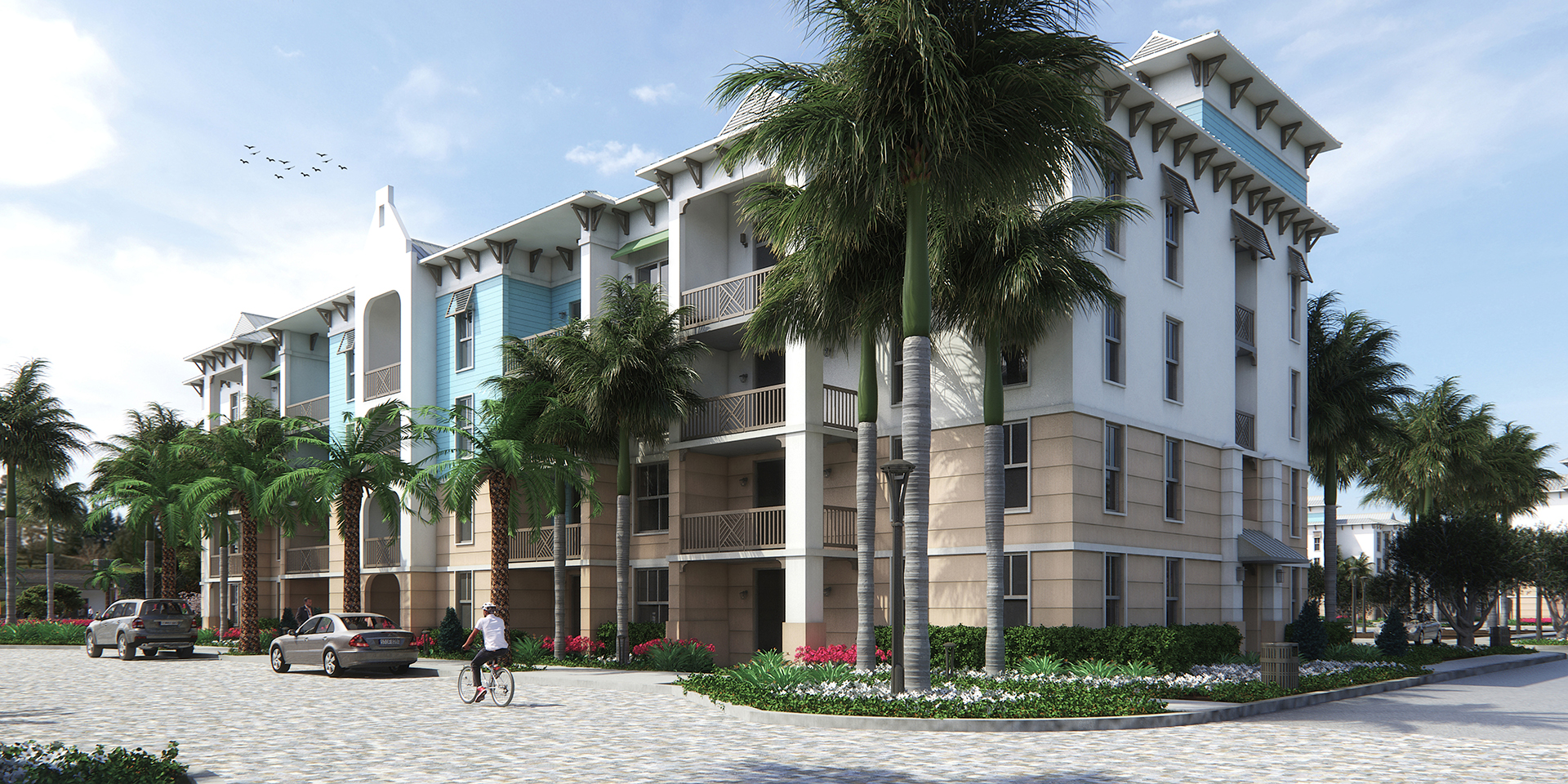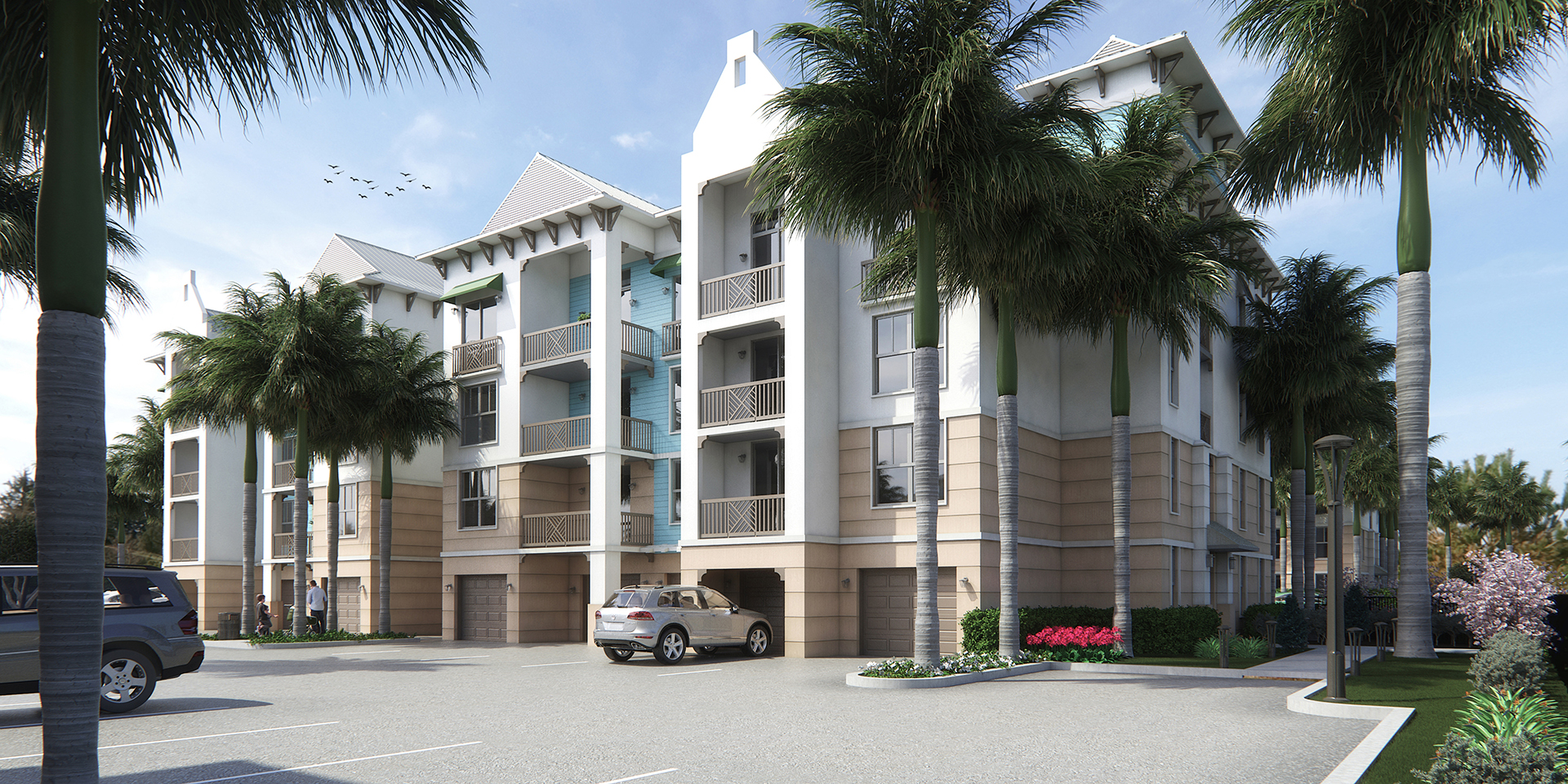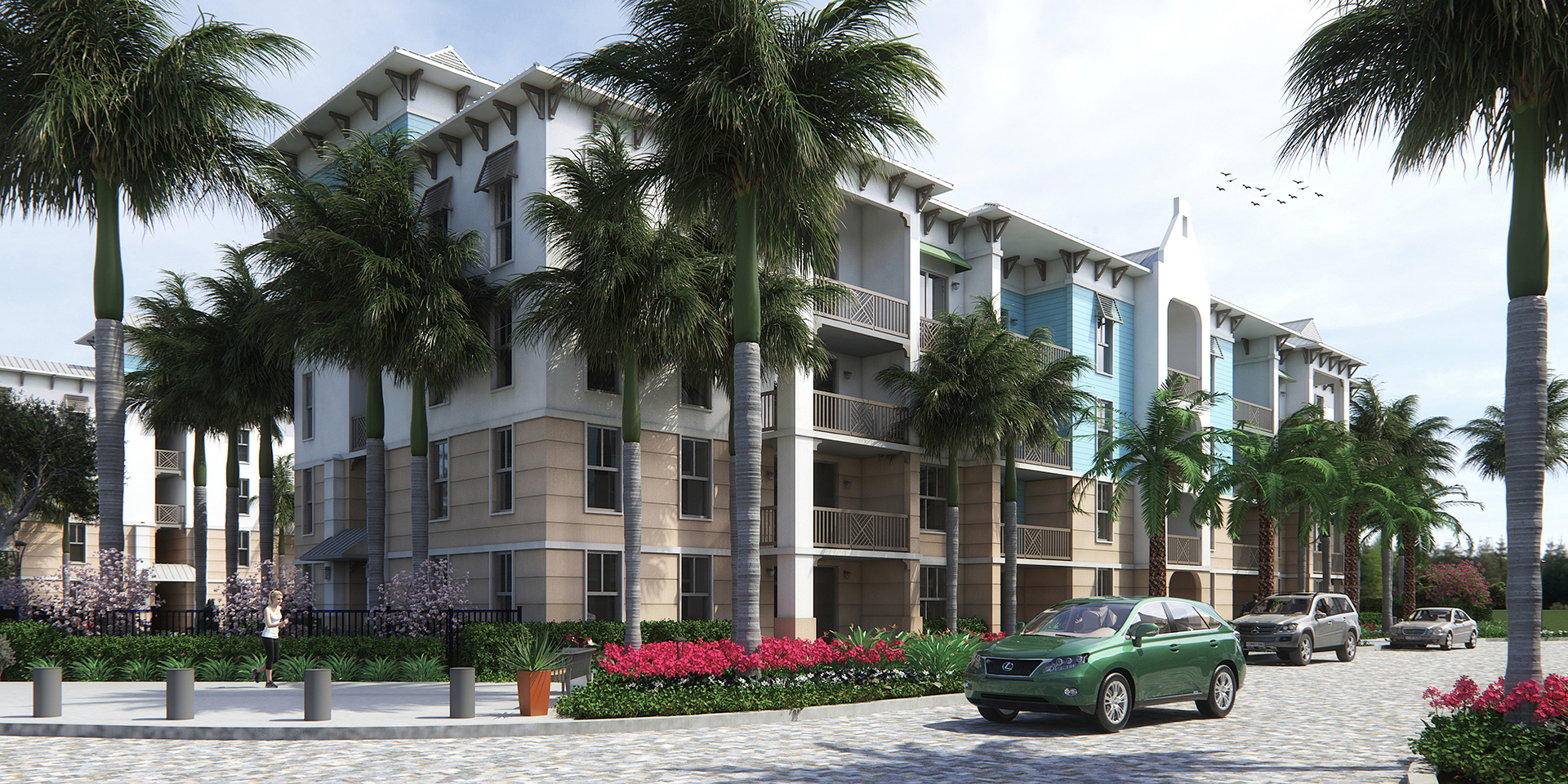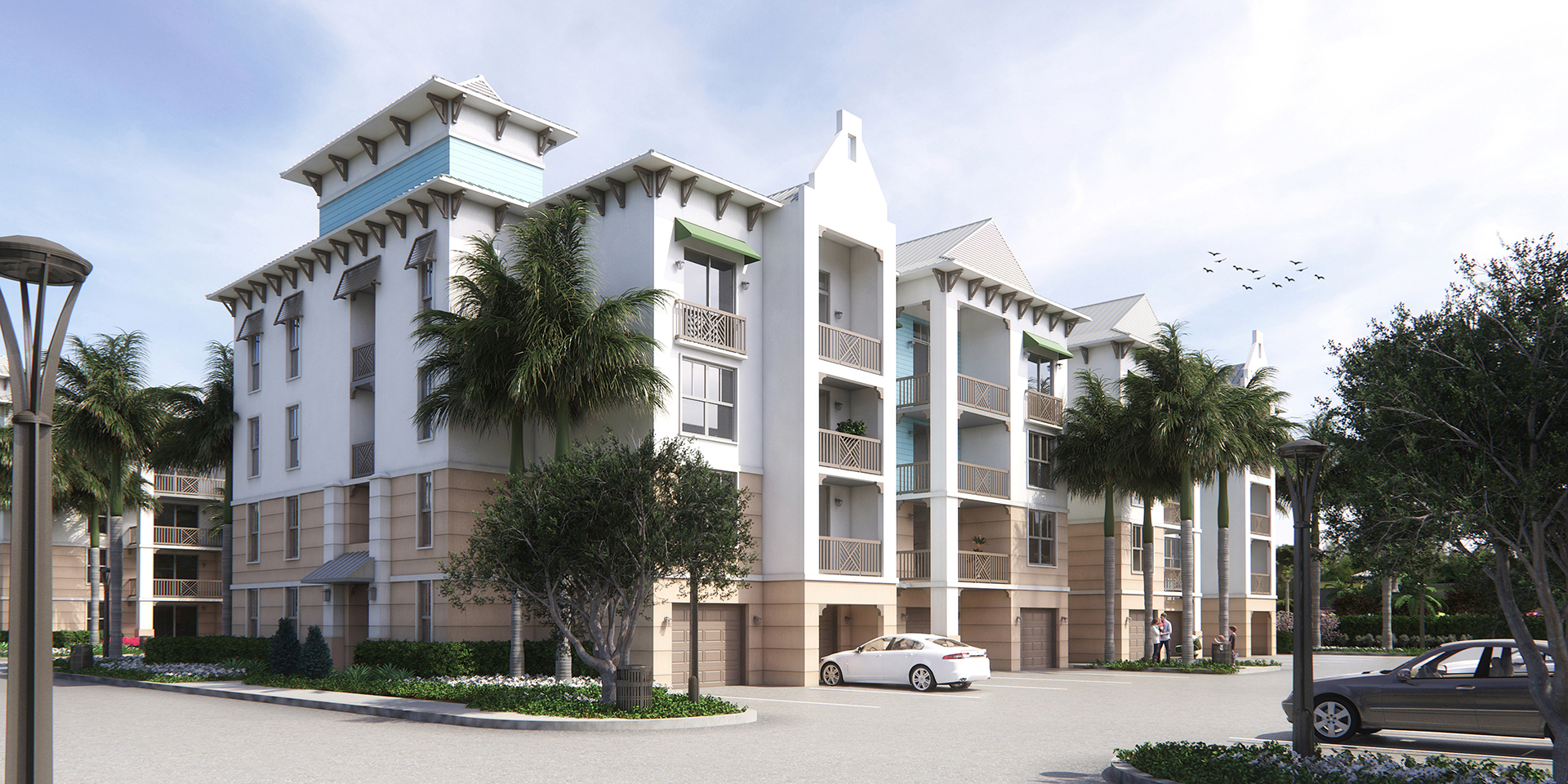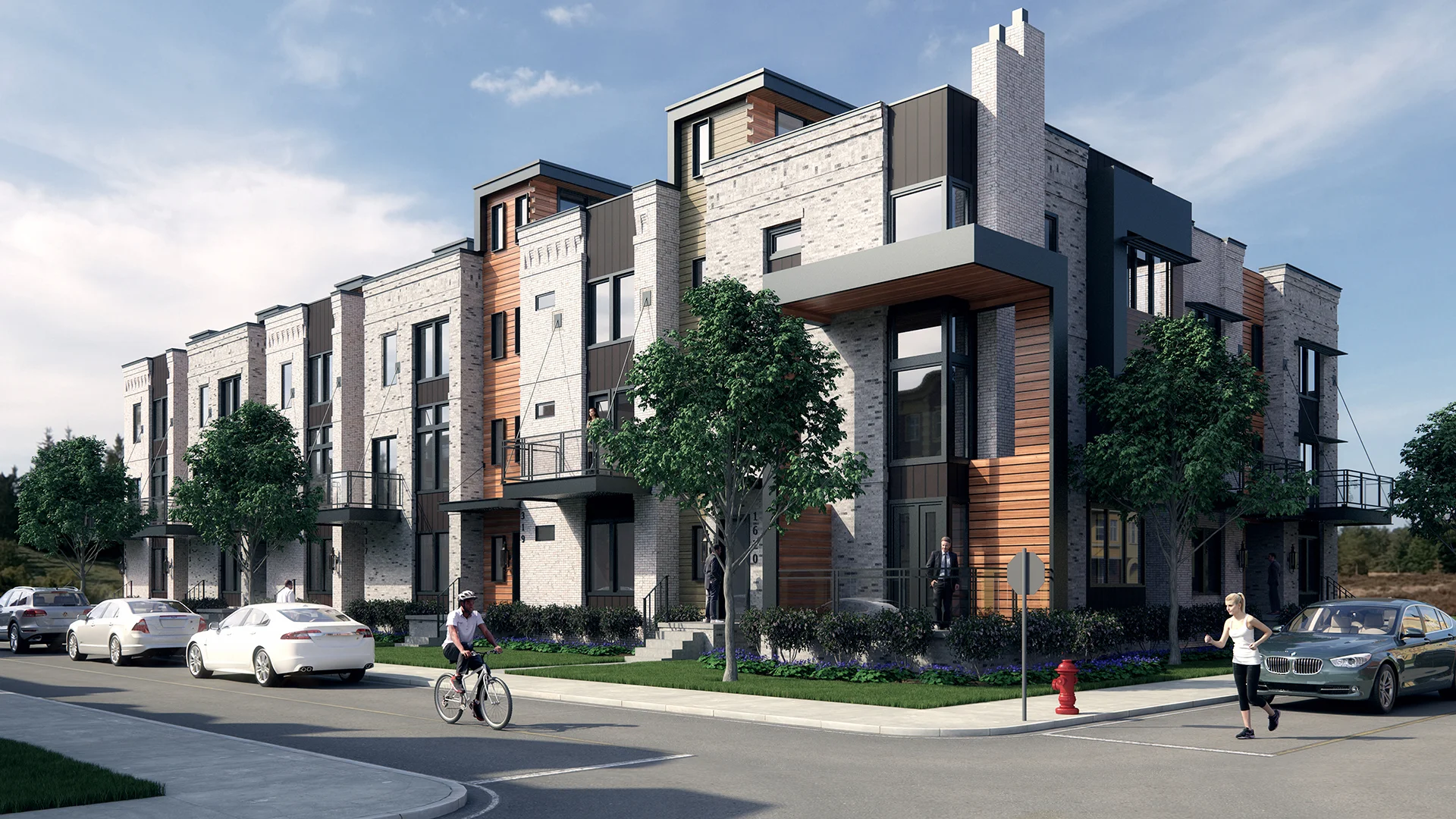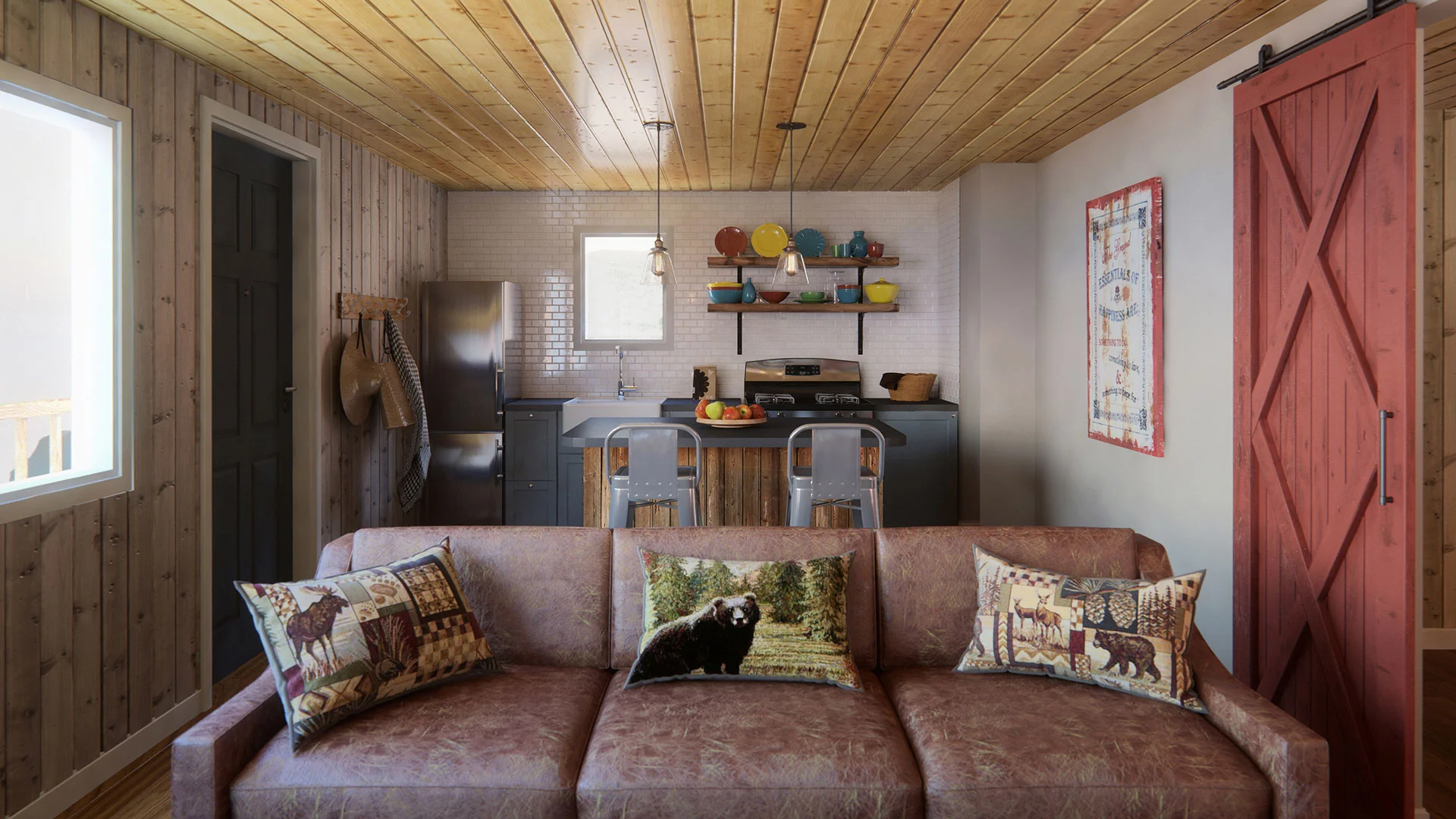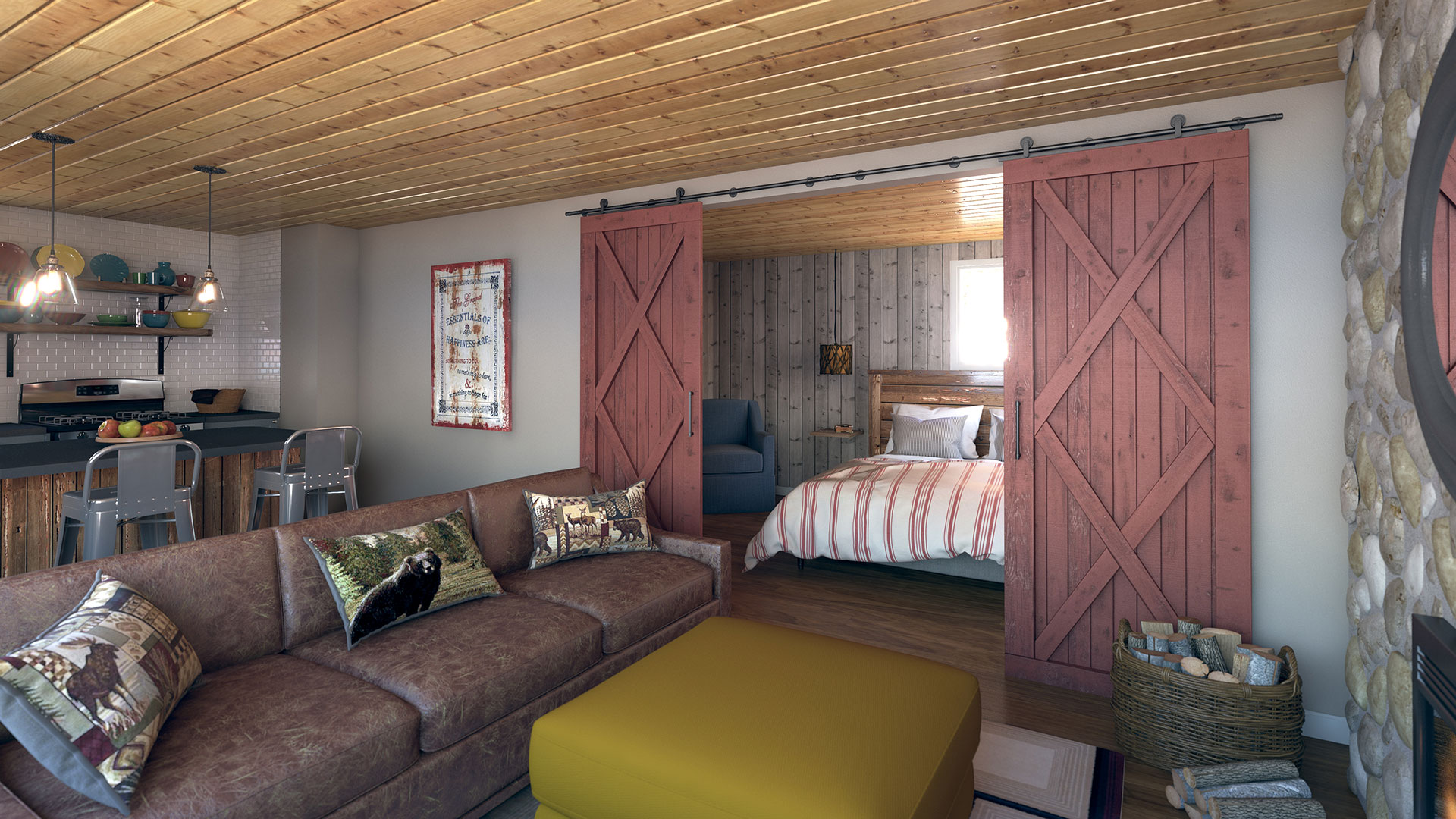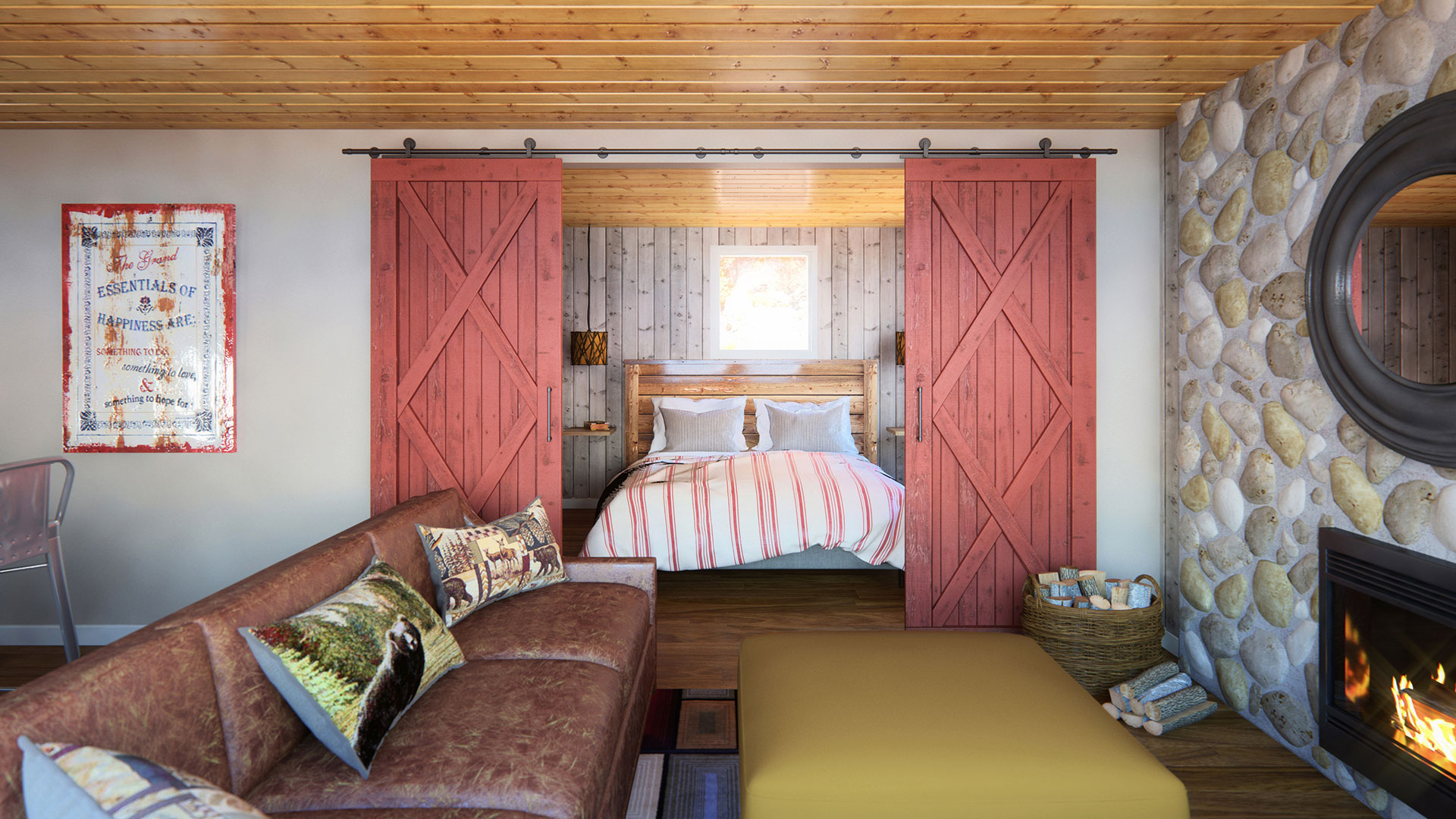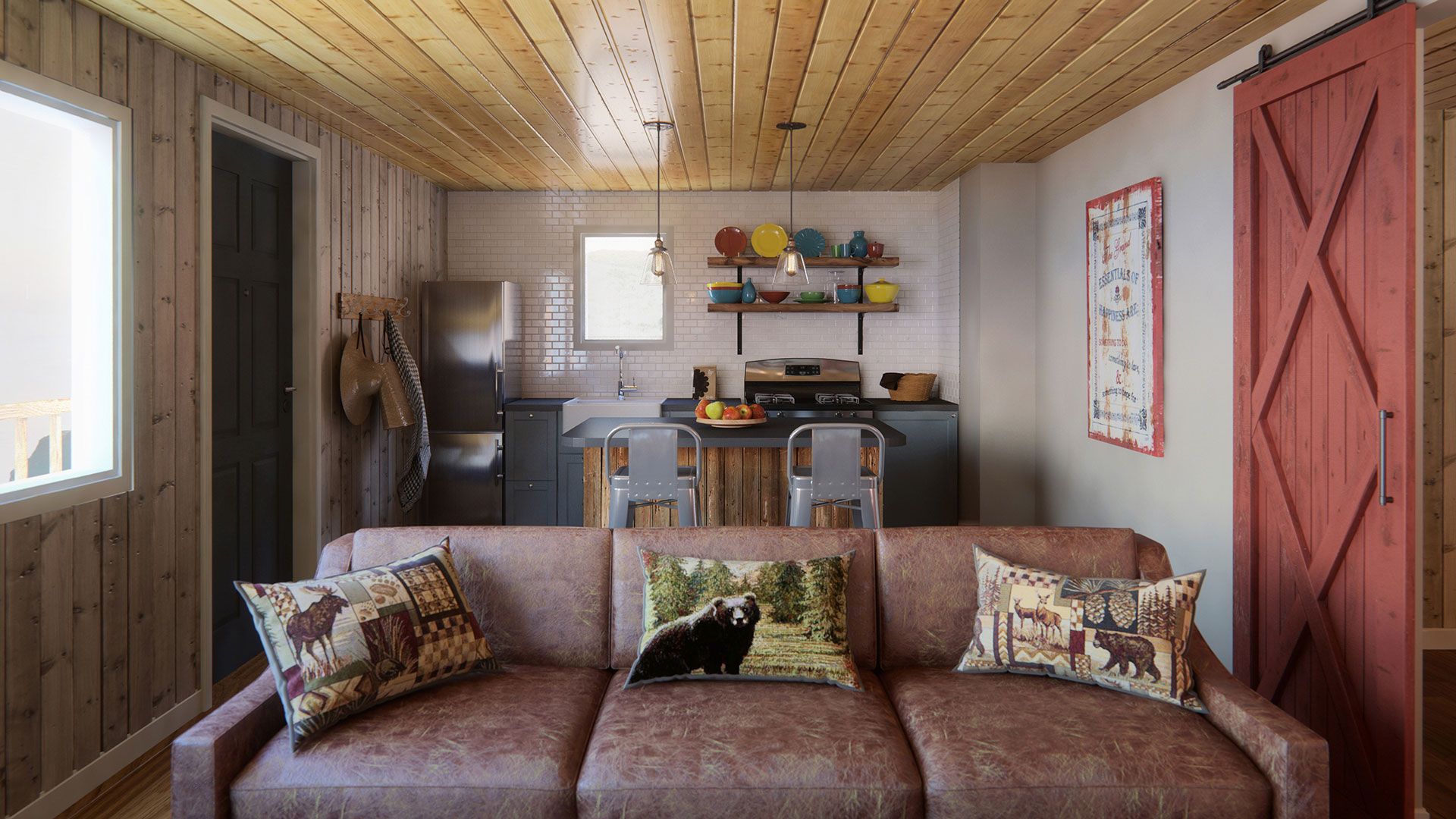BLOG
Seeing Tonal Contrast in Your Rendering
Tonal contrast is created when light tones and dark tones are positioned next to each other. The greater the difference between the two, in terms of brightness, the greater the tonal contrast. When viewing an architectural rendering, the eye tends to go to the brightest parts first. But, as the architectural illustrator, you want to direct the viewer’s eye to the part of the architectural rendering that you believe is the most important. A hallmark of the poorly composed architectural rendering is a conflict between where the architectural illustrator wants the viewer to look, and where visual elements within the architectural rendering (such as bright highlights) are pulling the viewer’s eye. A characteristic of the well-composed architectural rendering is that everything works in harmony. Visual elements pull the eye towards where the architectural illustrator wants it to go. All the elements work together, instead of fighting each other.
A little trick of mine is to squint while viewing your architectural rendering. By squinting, you'll remove detail and your architectural renderings contrast will really become evident.
Did you enjoy this article? I would love to hear your thoughts, so don’t be shy and comment below! Please don’t forget to subscribe to my RSS-feed or follow my feed onTwitter, Google+ andFacebook! If you enjoyed the following article we humbly ask you to comment, and help us spread the word! Or, if you would like, drop me an email.
What Makes a Good Architectural Rendering?
Architectural Renderings is part science, part art. On the technical side, you need to understand software (most renderings stop here) Then there’s the creative side, of which composition forms a large part. Here, there are no absolutes, and the discussion is much more subjective.
That’s why the answer to the question of what makes a good architectural rendering? varies widely depending on who you ask. However, there are principles (not rules) you can follow that will greatly help you improve your architectural rendering. There are two questions to ask yourself whenever you create an architectural rendering. They are:
- ‘How do I make this rendering more interesting?’
- ‘What am I trying to communicate?’
When someone asks how to improve the composition of an architectural rendering, what they are really asking is how can they make it more interesting or dramatic to look at, and how can they communicate the mood of the scene, or the moment they wanted to capture, more effectively? The answers to these questions help determine how the architectural rendering should be composed.
Did you enjoy this article? I would love to hear your thoughts, so don’t be shy and comment below! Please don’t forget to subscribe to my RSS-feed or follow my feed onTwitter, Google+ andFacebook! If you enjoyed the following article we humbly ask you to comment, and help us spread the word! Or, if you would like, drop me an email.
V-Ray Proxies and Large Scene Optimization
Recently, I had a large scene and some possible Windows 10 memory management issues, so I had to do something to lower my scenes RAM consumption. My solution was V-Ray's Proxies.
Here, are the plug-ins I used in my scene optimization, using V-Ray Proxies:
Did you enjoy this article? I would love to hear your thoughts, so don’t be shy and comment below! Please don’t forget to subscribe to my RSS-feed or follow my feed onTwitter, Google+ andFacebook! If you enjoyed the following article we humbly ask you to comment, and help us spread the word! Or, if you would like, drop me an email.
3D Artist 86 - Contribution
It's always nice to see your name in print. This month's addition to 3D Artist Magazine reached out to me last month for some tips on photorealistic architectural renderings. I was glad to help and here is some screen grabs of my name in lights. Get your copy, today!
Did you enjoy this article? I would love to hear your thoughts, so don’t be shy and comment below! Please don’t forget to subscribe to my RSS-feed or follow my feed on Twitter, Google+ andFacebook! If you enjoyed the following article we humbly ask you to comment, and help us spread the word! Or, if you would like, drop me an email.
Church Fund Raising Rendering
It's kind of difficult to get excited about a parking lot, but the Pastor of this church had an idea. Pastor Steve reached out to the civil engineer, who drew the plans, who then reached out to an architect, he knew, in regards to getting a rendering done for a fund raising campaign. Long, stony short, Pastor Steve gave me a call, I took his brief, and created him a parking lot rendering, showing the new parking lot.
Church Fundraising Rendering
I knew I couldn't just have a parking lot, so I built the 3d model of the existing building, using Google Earth Street Views. Then, I took the civil engineers 2d CAD drawings and modeled an accurate 3d model from them.
Now, the church fundraising rendering will be printed in bulletins, posted on a construction road sign, and it'll be posted on their website. Good luck, Pastor Steve, and I hope the rendering helps get your congregation excited about their new parking lot.
Did you enjoy this article? I would love to hear your thoughts, so don’t be shy and comment below! Please don’t forget to subscribe to my RSS-feed or follow my feed on Twitter, Google+
I Alway Ask for a Deposit
I Always Ask For a Deposit
I alway ask for a deposit before I start working on an architectural rendering project. There are three main reasons for this:
- I need to pay my bills, and I can’t wait until the end of a project to do that. Plus, I’m doing my best work, so I deserve to get paid during the work. Sometimes projects take a few weeks, or even months, and going without any money during that time is a hardship.
- The second reason is that sometimes, My client and I will decide to part ways before a project ends. That isn’t my fault. Clients occasionally run out of money or need to stop a project for reasons that have nothing at all to do with me. But if I have the project set up so that I don’t get paid until the end, I run the risk of walking away with nothing, even if I’ve already put a lot of hours in.
- Most projects require me to invest in new assets or maybe a plugin speciaclyy needed for that project
Agreeing with my clients on a few payments over the course of the project, which includes an initial deposit, assures me that my work wasn't done for nothing if we do part ways early.
Did you enjoy this article? I would love to hear your thoughts, so don’t be shy and comment below! Please don’t forget to subscribe to my RSS-feed or follow my feed on Twitter, Google+ and Facebook! If you enjoyed the following article we humbly ask you to comment, and help us spread the word! Or, if you would like, drop me an email.
Creating Tilable Brick in 3DS MAX
Making materials for your architectural rendering is both a science and an art. Like most things in life, the more effort you put into it, the better the results. Here, is my workflow for making bricks in 3DS MAX.
There are a lot of moving parts when building an architectural renderings. Some might think that there is a magic RENDER button, but there isn't. Out of the box, the software is dumb. It takes a good eye, lots of patience, and some good workflows.
Bricks are a tale-tale sign of a good architectural rendering from a poor one. Typically, brick covers larger areas, so the repeating pattern when using a bitmap is painfully obvious. Even when you are lucky enough to get a high resolution brick sample from your clients, it wasn't photographed to be repeated, so those can only get you so far. Here, in the video, I show you my brick workflow.
Did you enjoy this article? I would love to hear your thoughts, so don’t be shy and comment below! Please don’t forget to subscribe to my RSS-feed or follow my feed on Twitter, Google+ and Facebook! If you enjoyed the following article we humbly ask you to comment, and help us spread the word! Or, if you would like, drop me an email.
Market Price for Architectural Renderings
The market price for architectural renderings has a wide range, just like anything else. Just as a pair of jeans can be either very cheap or very expensive, the cost of an architectural rendering can vary greatly.
Would you buy a car for $50 and then use it to drive your kid to school? Probably not. When a car is being sold for a ridiculously low price, you know something stinks. Maybe the engine is rotten, or the police are looking for it. You know you get what you pay for, and a $50 car is probably a bad idea.
Some clients do think that architectural renderings are a commodity. Some think that all illustrators do the same job. We know that’s not the case at all.
Personally, I have a niche. I live and breathe architectural renderings. I have been in architecture for 25 years. Working within a niche means that I only work with clients in architecture. When I work on these projects and with my clients, I have increased my value for other clients in that same niche in the future.
I am always trying to improve my skills. Too many people stop improving on their technical skills as soon as they finish school. Do you think you know all of the shortcuts in Photoshop? Do you even know if Photoshop is the most efficient tool for you? Have you tried Sketch?
By investing time in improving my technical skills, I can get stuff done faster, which means a more profitable project. Even better, it means improved results.
I try and innovate my process. That’s right, innovation is not only for companies like Apple, it’s also something I do. What I mean by innovation is simply trying new ways of working, all the time. A new ways to send proposals, I try new workflows, I try running my meetings differently. The point of innovation is to find a better way to do the things I already do. By investing time in trying new and better ways to work, I can save a lot of hours and make myself more profitable. Trying new things takes time. Not every idea I have improved my workflow right away, but I consider this an investment that will pay off in the long run.
The architectural illustrator who charges too little, in a few weeks into the project, they will inevitably realize that they hadn’t priced the project correctly. They would then start suffering. The low-priced illustrators would lose all motivation and become hostile to their client, because they knew that they were losing money. The client would have no clue why, that they weren't nice anymore, and the project would stop being fun for both.
One of the biggest questions I am asked is, "how much do you charge for a rendering?". After 25 years of doing architectural renderings, I am still confused by this question. An example would be to call your local real estate agent and ask how much does a house cost. There are many questions to get answered before a price can be given.
First, I would need to see the plans and elevations. Each project is unique and each project has its own obstacles and challenges.
Also, doing something I love and find meaningful is a major part of why I chose to be in this business in the first place. And some clients have more exciting projects to work on than others. To be totally transparent, As a rule, if I’m not that excited about a project, I always charge more. By doing so, I make it worth my time to work on something that’s probably going to bore me. It also makes it possible for me to take on more interesting, but less profitable projects as well. On the other hand, if I’m super interested, I might not push the price too high, to increase my chances of getting the project.
Every project I take on is another part of my career journey. It will have an effect on my future. Understanding the long-term effect a certain project might have will help me to understand the true value of the project, and therefore how to price it correctly.
Tamarac Village Renderings
Tamarac Village is a large development in Florida. My objective was to produce 12 photo
Did you enjoy this article? I would love to hear your thoughts, so don’t be shy and comment below! Please don’t forget to subscribe to my RSS-feed or follow my feed on Twitter, Google+ and Facebook! If you enjoyed the following article we humbly ask you to comment, and help us spread the word! Or, if you would like, drop me an email.
Adam's House Rendering
What a pleasant project to work on. I really enjoy helping architects, builders, and developers show their clients what their client's dream house will look like. Architectural renderings really help the client get engaged and excited about their future dream home.
House Architectural Rendering - Day
House Architectural Rendering - Day
Did you enjoy this article? I would love to hear your thoughts, so don’t be shy and comment below! Please don’t forget to subscribe to my RSS-feed or follow my feed on Twitter, Google+ and Facebook! If you enjoyed the following article we humbly ask you to comment, and help us spread the word! Or, if you would like, drop me an email.
Recommended on Houzz
Always an honor to be acknowledged for my work. I have received a Houzz Recommended badge.
Did you enjoy this article? I would love to hear your thoughts, so don’t be shy and comment below! Please don’t forget to subscribe to my RSS-feed or follow my feed on Twitter, Google+ and Facebook! If you enjoyed the following article we humbly ask you to comment, and help us spread the word! Or, if you would like, drop me an email.
Modern Townhouse Rendering
Modern living! It took me awhile to warm up to these modern building renderings that I have been illustrating, but I think I am liking them. I like the metals with the stone and the hard clean lines.
Modern Townhouse Rendering - Day
Modern Townhouse Rendering - Nigh
Did you enjoy this article? I would love to hear your thoughts, so don’t be shy and comment below! Please don’t forget to subscribe to my RSS-feed or follow my feed on Twitter, Google+ and Facebook! If you enjoyed the following article we humbly ask you to comment, and help us spread the word! Or, if you would like, drop me an email.
The Gramercy Architectural Rendering
I shared the project earlier last month, but the project was sold, so the new owner has made some changes in architecture prior to a press release.
“Those are incredible!!!!!!”
Modern Architecture Day Rendering
Modern Architecture Night Rendering
Did you enjoy this article? I would love to hear your thoughts, so don’t be shy and comment below! Please don’t forget to subscribe to my RSS-feed or follow my feed on Twitter, Google+ and Facebook! If you enjoyed the following article we humbly ask you to comment, and help us spread the word! Or, if you would like, drop me an email.
Commercial Architectural Rendering
“Bobby is extremely talented with his rendering abilities, very accommodating and quick turn around times.”
Quite a lot of architecture flows past my desk and I am not a fan of some, however, I really appreciate the proposed building for 220 Graham Ave., Eau Claire, WI.
220 Graham Ave Proposed Commercial Rendering
River Valley Architects approached me to prepare them a presentation rendering for a city council meeting. I received a solid Revit model, which is always nice, and a complete color board. Since the model wasn't built to illustrate, I had to spend a few days working the model into something I can use. I created many custom textures, which no repeating pattern can be seen, set up the lighting, and arrange the composition.
Since I had some good architecture to start with, the final architectural rendering turned out great. I wish the architect the best of luck and I hope to see it built.
Did you enjoy this article? I would love to hear your thoughts, so don’t be shy and comment below! Please don’t forget to subscribe to my RSS-feed or follow my feed on Twitter, Google+ and Facebook! If you enjoyed the following article we humbly ask you to comment, and help us spread the word! Or, if you would like, drop me an email.
See it Live: Autodesk 3ds Max 2016 Extension 1
Join Chris Murray as he takes you on a tour of 3ds Max 2016: See how new tools and new workflows help you get started quickly, work better, and collaborate like never before.
Did you enjoy this article? I would love to hear your thoughts, so don’t be shy and comment below! Please don’t forget to subscribe to my RSS-feed or follow my feed on Twitter, Google+ and Facebook! If you enjoyed the following article we humbly ask you to comment, and help us spread the word! Or, if you would like, drop me an email.
Custom Elder Care Interior Rendering
Definition of CUSTOM: adjective
made or done to order for a particular customer.
From the furniture, to the artwork, and the fabrics, everything were custom modeled and texture mapped to the interior designer's specifications.
After a couple iterations, here are the final renderings for a proposed elder care. The space is rather tall and I wanted to show the height of the space, so I chose this aspect ratio. With a subtle depth of field, and some warm lighting, I think the space turned out beautifully.
Did you enjoy this article? I would love to hear your thoughts, so don’t be shy and comment below! Please don’t forget to subscribe to my RSS-feed or follow my feed on Twitter, Google+ and Facebook! If you enjoyed the following article we humbly ask you to comment, and help us spread the word! Or, if you would like, drop me an email.
How to get your first high paying client (step by step)
Hey there guys and gals of the
If you got yesterday’s email, then you know I was blown away when I discovered that my designer friend was charging more money for 2 days of work than what I got for a full time position.
I was set up to try and create that for myself.
This email is not about telling another story, but rather explaining to you EXACTLY what I did to get my first client to pay me the same.
Pay attention, because these strategies can really make a difference in your freelance business:
The Meeting
There’s a lot of psychology going into meeting a potential client for the first time, much like
Here’s what I did:
I set the meeting on my own terms: I told them I can only meet on a certain day and time for 30 minutes, and mentioned the location where I can meet them. This created the impression that I was so busy and therefore probably very good and expensive.
I asked most of the questions: I did not let the client lead the meeting and interview me. I came prepared with a set of questions and I interviewed them. This is much more professional and creates the impression that I have to PICK THEM, rather than the other way around.
I told them I will get back to them: after I got everything I needed to know about the project, I did not tell them how much it would cost right away (even though they wanted to know), I just said: “let me think about it, and see what I can do for you”. Again: the ball is in my court.
The Proposal
The client was a startup that needed help designing their app.
I realized that if I gave them a proposal for the project they just asked for, I will probably lose 90% of the design work in this project, since all the work is going to happen AFTER the app actually launches.
Here’s what I did:
I created a project
gantt : I broke down the work into weeks so that I could show them how we’re going to meet their deadlines, and what’s going to happen each week. I did this for 12 weeks - the next 3 months.I created a retainer program: I told my client that I will charge them $5,000 a month, and that we can end the relationship at any time if we are not happy together. That means that for the entire project (total of 3 months) they will pay me $15,000.
I showed them what we can do next: I created an additional list of things I thought the startup could benefit from - new branding, a marketing video and a new website, among others. I showed them how we can fit some of them in before the launch, and as for the rest, we’ll continue working
on them should the first three months prove successful.
It took the client about 2 days to think this over (and
While other designer’s just gave them a price tag for the app design, I showed them how we can work together as a team, for the long term and I was invested in helping their company succeed. I showed them more than they’ve asked for and I helped them imagine what a great brand and design will do for their business.
Here are the key takeaways:
Negotiation starts before you even discuss money. If your client desperately wants to work with you because you are a superstar designer, they will be willing to pay. Present yourself as that superstar designer (without being a
douchebag of course.)Don’t give the client a proposal for what they asked for. A lot of times clients are not even sure what problem they are actually trying to solve. Do some thinking and then propose to them the best thing for their business. And guess what - the best thing for their business is in many cases to work with a designer on a regular basis.
Make it easy to say “YES!”. Your proposal needs to address your client’s fears and also to fulfill their dreams. It’s not only about the money - it’s about what that money buys.
I hope you think about this the next time you are about to meet a potential client.
There’s no reason why you won’t be able to make them happy with a proposal like this.
Now go kick some ass!
Ran.
PS
Yesterday I
Tennessee Luxury Townhome Rendering
This project went through an ownership change mid stream, however, I was able to complete the project for the new owners marketing team.
These luxury Townhome renderings are the third project that I completed for the same architect. Although I worked closely with the architect, the developer reached out to me to inquire about my services. After a few emails back and forth, and I believe a phone call, I was awarded my first project with the developer. The architect sent me his SketchUp model, which was created as a design model, and I took took it from there.
The architect, developer and I, worked back and forth for about a month. The process was mainly to work through some brick choices for the historical society. After about four color iterations, here is the final 3d renderings, showing the final design, which will be used to market the townhomes.
Day Townhouse 3D Rendering
Twilight Night Rendering
Did you enjoy this article? I would love to hear your thoughts, so don’t be shy and comment below! Please don’t forget to subscribe to my RSS-feed or follow my feed on Twitter, Google+ and Facebook! If you enjoyed the following article we humbly ask you to comment, and help us spread the word! Or, if you would like, drop me an email.
Lake Superior Cabin Renderings
What a fun little architectural rendering project. I first got contacted by this builder several months ago. After nurturing the lead a little, their interior designer contacted me in regards to these little cabins that they'll be marketing. They loved my interior architectural rendering portfolio and wanted to commission me to work on their project.
Of course, I accepted and after a few iterations, these are how they turned out. I hope you enjoy them. If you have any questions or comments, feel free to reach out to me by commenting on this post, or emailing me.
Did you enjoy this article? I would love to hear your thoughts, so don’t be shy and comment below! Please don’t forget to subscribe to my RSS-feed or follow my feed on Twitter, Google+ and Facebook! If you enjoyed the following article we humbly ask you to comment, and help us spread the word! Or, if you would like, drop me an email.
Favourite settings for V-Ray 3.x
Here, is a video that Vladimir Koylazov share of his favorite V-Ray 3.x features. In my opinion, he really simplifies the workflow, and it's worth your time to watch.
Did you enjoy this article? I would love to hear your thoughts, so don’t be shy and comment below! Please don’t forget to subscribe to my RSS-feed or follow my feed on Twitter, Google+ and Facebook! If you enjoyed the following article we humbly ask you to comment, and help us spread the word! Or, if you would like, drop me an email.












